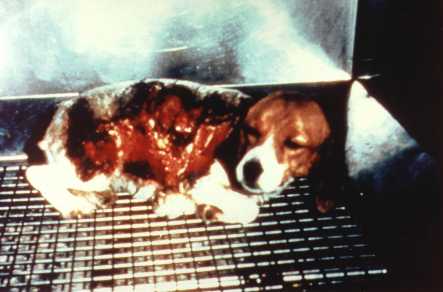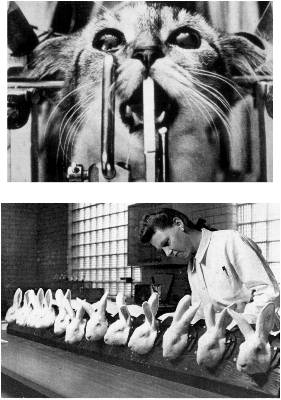Animal Rights
For the vegetarians!!

Calves, characteristically pale from the breeders
infliction of anemia, separated from the mother
and raised for meat production.
Vegans don't care if cheese does or does not contain animal rennet - which is obtained from the stomach of the slaughtered animals. Cheeses, even if biological, are always obtained from the suffering of many animals
..>..>

Hens used for egg production are raised in battery cages.
Notice the soil (excrement) everywhere
Egg production translates to the death of the hens and male chicks. Hens normally would live fifteen years outside of this prison, but in breeding cages their lives are short (about 2 years) and when their productivity slows down they are slaughtered. Don't be fooled, the consumption of eggs also stimulates meat production. Beyond the shortened lifespan of the dead hens, there is also intense exploitation of these animals. The male chicks, which are useless to the productive cycle, are thrown into a mincer to become feed. Even worse, they are simply suffocated or just left to die in great heaps.

Bodies of chicks jettisoned into the trash:
this is the unavoidable fate of the male chicks

In the breeding cages, this machine
cuts the chick's beaks
Healthy choices on a vegan diet
Decades of experience, culminating in more than a million vegans today, have shown that appropriate vegan diets support good health at all stages of life and reduce the risk of heart disease. This has been confirmed by independent scientific studies. Adopting a plant-based diet is the most important step you can take towards limiting your contribution to animal suffering. Most people decide to take a further step and eliminate animal products from other areas of their life.
Animal Experimentation

Some baby monkeys, imported to be used for laboratory experiments, were found dead on their arrival at London airport (UK

Monkeys in a restraining device subjected to neurological experiments conducted by Dr. Edward Taub. Dr. Taub is the only vivisector to have been tried and sentenced for cruelty to animals. Later, on appeal he was exculpated for a legal cavil: his experiments were not subjected to animal protection regulations.

Bodies of animals submitted to vivisection: after being used in several experiments, the bodies of these animals are easily thrown away.


Britches, the monkey liberated from the University of California at Riverside laboratory by the Animal Liberation Front (ALF) in 1985. The vivisectors had sewn the baby monkeys' eyelids together and grafted a sonar device onto her head

To test the effects of burns, this dog was burned alive at the Shriner's Hospital, Cincinnati, USA.

Biomedical research laboratory or Auschwitz

1.Experiment on the brain of a cat that has been immobilized in a restraining device-
2.Draize Test on rabbits in restraining devices (Liverpool, UK). The substance to be tested is poured into the rabbits' eyes and onto their skin, and left there for days until the organ becomes necrotic. This test was invented in 1944, and continues to be used, unaltered. It is one of the many demonstrations of how these practices are used purely due to inertia, because there is no real desire to evolve and use more moral and scientific methods.
Historical impact of animal experimentation
http://www.mrmcmed.org
Proponents of animal experimentation (tests, experiments and "educational" exercises involving harm to animals) claim that it has played a crucial role in virtually all medical advances.5,6 However, several medical historians argue that key discoveries in such areas as heart disease, cancer, immunology, anesthesia and psychiatry were in fact achieved through clinical research, observation of patients and human autopsy.7-16
Human data has historically been interpreted in light of laboratory data derived from nonhuman animals. This has resulted in unfortunate medical consequences. For instance, by 1963 prospective and retrospective studies of human patients had already shown a strong correlation between cigarette smoking and lung cancer.17,18 In contrast, almost all experimental efforts to produce lung cancer in animals had failed. As a result, Clarence Little, a leading cancer animal experimenter, wrote: "The failure of many investigators to induce experimental cancers, except in a handful of cases, during fifty years of trying, casts serious doubt on the validity of the cigarette-lung cancer theory."19 Because the human and animal data failed to agree, this researcher and others distrusted the more reliable human data. As a result, health warnings were delayed for years, while thousands of people died of lung cancer.
By the early 1940s, human clinical investigation strongly indicated that asbestos causes cancer. However, animal studies repeatedly failed to demonstrate this, and proper workplace precautions were not instituted in the U.S. until decades later.20 Similarly, human population studies have shown a clear risk from exposure to low-level ionizing radiation from diagnostic X-rays and nuclear wastes,21-24 but contradictory animal studies have stalled proper warnings and regulations.25 Likewise, while the connection between alcohol consumption and cirrhosis is indisputable in humans, repeated efforts to produce cirrhosis by excessive alcohol ingestion have failed in all nonhuman animals except baboons, and even the baboon data is inconsistent.26
Many other important medical advances have been delayed because of misleading information derived from animal "models". The animal model of polio, for example, resulted in a misunderstanding of the mechanism of infection. Studies on monkeys falsely indicated that the polio virus was transmitted via a respiratory, rather than a digestive route.27,28 This erroneous assumption resulted in misdirected preventive measures and delayed the development of tissue culture methodologies critical to the discovery of a vaccine.29,30 While monkey cell cultures were later used for vaccine production, it was research with human cell cultures which first showed that the polio virus could be cultivated on non-neural tissue.31 Similarly, development of surgery to replace clogged arteries with the patient's own veins was impeded by dog experiments which falsely indicated that veins could not be used.32 Likewise, kidney transplants, quickly rejected in healthy dogs, were accepted for a much longer time in human patients.33 We now know that kidney failure suppresses the immune system, which increases tolerance of foreign tissues.
Nevertheless, society continues to support animal experimentation, primarily because many people believe that it has been vital for most medical advances.34 However, few question whether such research has been necessary or even beneficial to medical progress.
Professional Opinions on Vivisection
"Animal model systems differ from their human counterparts. Conclusions drawn from animal research, when applied to human beings, are likely to delay progress, mislead, and do harm to the patient. Vivisection, or animal experimentation, should be abolished." Dr. Moneim Fadali, M.D., 1987, F.A.C.S., Diplomat American Board of Surgery and American Board of Thoracic Surgery, UCLA faculty, Royal College of Surgeons of Cardiology, Canada.
"Experiments on animals do not only mean torture and death for the animals, they also mean the killing of people. Vivisection is a double-edged sword." Major R.F.E.Austin, M.D.,1927, Royal College of Surgeons, Licentiate of the Royal College of Physicians.
"It is well known that animal effects are often totally different from the effects on people. This applies to substances in medical use as well as substances such as 245y and dioxin." A.L.Cowan, M.D., 1985, Acting Medical Officer of Health, New Plymouth, N. Z.
"Normally, animal experiments not only fail to contribute to the safety of medications, but they even have the opposite effect." Prof. Dr. Kurt Fickentscher, 1980, of the Pharmacological Institute of the University of Bonn, Germany.
"Experiments on animals lead inevitably to experiments on people...As if an animal experiment could ever predict the same result on a person. And as if an experiment on one human being could enable us to foresee the reactions of another human being, whose biology and metabolism are different, whose blood pressure is different, whose lifestyle and age and nourishment and sensitivity and genes and everything else are different...We recognise that each single organism, whether human or animal, has its very own reactions...Today's orthodox medicine and suppressive surgery don't understand the purpose of disease and therefore don't know how to treat it. A real doctor's experience derives from his natural intuition coupled with his observation at the sickbed, but never from invasive, violent experiments on people, and much less on animals. Instead of vital hygiene, which aims at preservation or reconstruction of health by natural means and shuns all use of degrading, destructive chemicals, today's medical students are only taught to manipulate poisons and mutilate bodies. We demand that this be changed." Prof. Andre Passebecq, M.D., N.D., D.Psyc., 1989, Faculty of Medicine of Paris, then President of the International League of Doctors Against Vivisection (ILDAV).
ps. Thanks to Kerry-Anne for finding this info
pps. Yes, I'm doing something about it, I'm donating $40 a month to WSPA and am also vegetarian. ^^
ppps. Humans suck :(